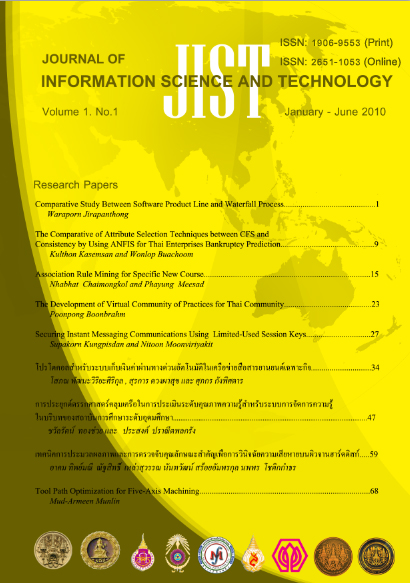Satisfaction of Academic Service and Learning Environment for Graduates Student at School of Information Technology, King Mongkut’s University of Technology Thonburi
Main Article Content
Abstract
- The purpose of this research was to study student satisfaction toward learning environment and academic services. The samples are graduate students at the School of Information Technology, King Mongkut’s University of Technology Thonburi. The student satisfaction model is proposed in this research and proves by enquiry the satisfaction from graduate students. The study focuses on four aspects: academic service, library service, audio-visual aids service and the school learning environment. The samples of the study were 898 graduate students who registered in the second semester of academic year 2008. They were classified by gender, age, current fields of study, work experiences, and work status. The instrument for data collection was five point rating scale questionnaire containing 34 questions with reliability of 0.96. The statistics methods used for data analysis were frequency, percentage, means, standard deviation, T-test, and one way analysis of variance. The research finding revealed that the students had the satisfaction at a moderate level in all aspects, except the aspect of academic service, which was at a high level. Gender was found to have significant difference at 0.05 levels for learning events. Ages and fields of study had no significant difference in all aspects of satisfaction. However, it was found that the satisfaction toward learning environment had significant difference at 0.05 levels. The research result can be used as guidelines for academic service at any Information Technology related School.
Article Details
This work is licensed under a Creative Commons Attribution-NonCommercial-NoDerivatives 4.0 International License.
I/we certify that I/we have participated sufficiently in the intellectual content, conception and design of this work or the analysis and interpretation of the data (when applicable), as well as the writing of the manuscript, to take public responsibility for it and have agreed to have my/our name listed as a contributor. I/we believe the manuscript represents valid work. Neither this manuscript nor one with substantially similar content under my/our authorship has been published or is being considered for publication elsewhere, except as described in the covering letter. I/we certify that all the data collected during the study is presented in this manuscript and no data from the study has been or will be published separately. I/we attest that, if requested by the editors, I/we will provide the data/information or will cooperate fully in obtaining and providing the data/information on which the manuscript is based, for examination by the editors or their assignees. Financial interests, direct or indirect, that exist or may be perceived to exist for individual contributors in connection with the content of this paper have been disclosed in the cover letter. Sources of outside support of the project are named in the cover letter.
I/We hereby transfer(s), assign(s), or otherwise convey(s) all copyright ownership, including any and all rights incidental thereto, exclusively to the Journal, in the event that such work is published by the Journal. The Journal shall own the work, including 1) copyright; 2) the right to grant permission to republish the article in whole or in part, with or without fee; 3) the right to produce preprints or reprints and translate into languages other than English for sale or free distribution; and 4) the right to republish the work in a collection of articles in any other mechanical or electronic format.
We give the rights to the corresponding author to make necessary changes as per the request of the journal, do the rest of the correspondence on our behalf and he/she will act as the guarantor for the manuscript on our behalf.
All persons who have made substantial contributions to the work reported in the manuscript, but who are not contributors, are named in the Acknowledgment and have given me/us their written permission to be named. If I/we do not include an Acknowledgment that means I/we have not received substantial contributions from non-contributors and no contributor has been omitted.
References
2. Baker, A. A., Tillmann, A., and KrÖmker, D. (2010), Using Self-Assessments for Predicting the Success of Study, IEEE Xplore, pp. 1-5.
3. Yang Z., Yan-Ping, L., ad Jie, T. (2006), Study on Quality Indicators on Higher Education: An Application of the SERVQUAL Instrument, IEEE Xplore, pp. 1-7.
4. ไพฑูรย์ ศรีฟ้า. (2552). การจัดสภาพแวดล้อมทางการเรียน. สืบค้นเมื่อ 23 เมษายน 2552, จาก http://isc.rua.c.th/data/EED0000366.doc
5. ชริณี เดชจินดา. (2530). ความพึงพอใจของผู้ประกอบการต่อศูนย์บริการอุตสาหกรรม แขวงแสมดำ เขตบางขุนเทียน. ปริญญานิพนธ์ สค.ม. (สิ่งแวดล้อม). กรุงเทพฯ: บัณฑิตวิทยาลัยมหาวิทยาลัยมหิดล.
6. กฤตนัน มาย อาริยวัฒน์. (2552). ทฤษฏีความพึงพอใจ .สืบค้นเมื่อ 5 พฤษภาคม 2552, จาก http://earners.in.th/blog/espade/2218897.
7. Coleman, J. S., (1990), Foundation of Social Theory. Cambridge, Mass. Harvard University Press.
8. จิตตินันท์ เดชะคุปต์. (2538). จิตวิทยาการบริการ. กรุงเทพฯ: มหาวิทยาลัยสุโขทัยธรรมาธิราช.
9. Mullins. (1985), Management and Organizational Behaviour. London: Pitman Publishing, pp. 397-400.
10. พิมลพรรณ หิรัณยเอกภาพ. (2552). เข้าใจสภาพแวดล้อมภายในมหาวิทยาลัย. สืบค้นเมื่อ 24 เมษายน 2552, จาก http://earners.in.th/blog.
11. ดวงเดือน พิพัฒน์ชูเกียรติ. (2541). ปัจจัยที่มีความสัมพันธ์กับความสุขสมบูรณ์ของนักศึกษาชั้นปี ที่ 1 มหาวิทยาลัยธรรมศาสตร์ ศูนย์รังสิต. ปริญญานิพนธ์ กศ.ม. (สุขศึกษา). กรุงเทพฯ: บัณฑิตวิทยาลัย มหาวิทยาลัยธรรมศาสตร์.
12. สำเนาว์ ขจรศิลป์. (2537). มิติใหม่ของกิจการนักศึกษา. กรุงเทพฯ: มหาวิทยาลัยเกษตรศาสตร์.



